Douglas County’s 37 historic, landmarked properties are listed below in alphabetical order.
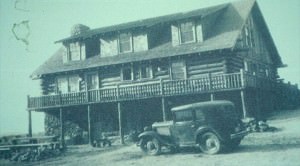
The Abbe Ranch House was the only home of the James and Polly Abbe family. James Abbe was a well-known photographer, having photographed many stars of the silent screen. He also covered the Spanish Civil War from 1936 to 1937, opposite Ernest Hemmingway. He was the first Western photographer to photograph Stalin.
The children, Patience, Richard and John, wrote three books and were famous in their own right. The Abbes purchased the land and constructed the home with the proceeds of the children’s books. The children were the actual owners of the home. The ranch house was completed in 1938. Today the Abbe Ranch House is a private property.
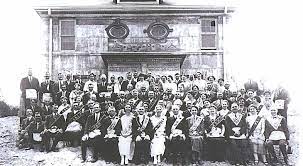
The American Federation of Human Rights was added to the National Register of Historic Places in March 1998. The largest building on the property is the Administration building, which serves as the headquarters office and contains a temple and library. Construction began in 1919 and the building was completed in 1924. The two-story structure is constructed in the foursquare style and has white stucco walls, blue trim, and a red tile roof. In all, there are seven contributing buildings on the American Federation property.
Another predominant building on the property is the one-story Brick House, which has a full basement. Construction of the classic cottage-style home began in 1918 and finished in 1923.
The American Federation of Human Rights was the corporate arm of the Co-Masonry fraternal order, which was part of the effort to establish national organizations through which workers could bargain more effectively for better working conditions. In addition, Co-masonry represented the trend toward the further emancipation of women. In 1916, the organization purchased acreage in Larkspur to serve as its federation headquarters, a retirement home for coal miners affected by lung disease, and a home for widows and orphans. Due to the Nazi occupation of Paris during World War II, this property served as the international headquarters of the International Co-Masonry until 1946. The American Federal of Human Rights remains the current owner of the property.
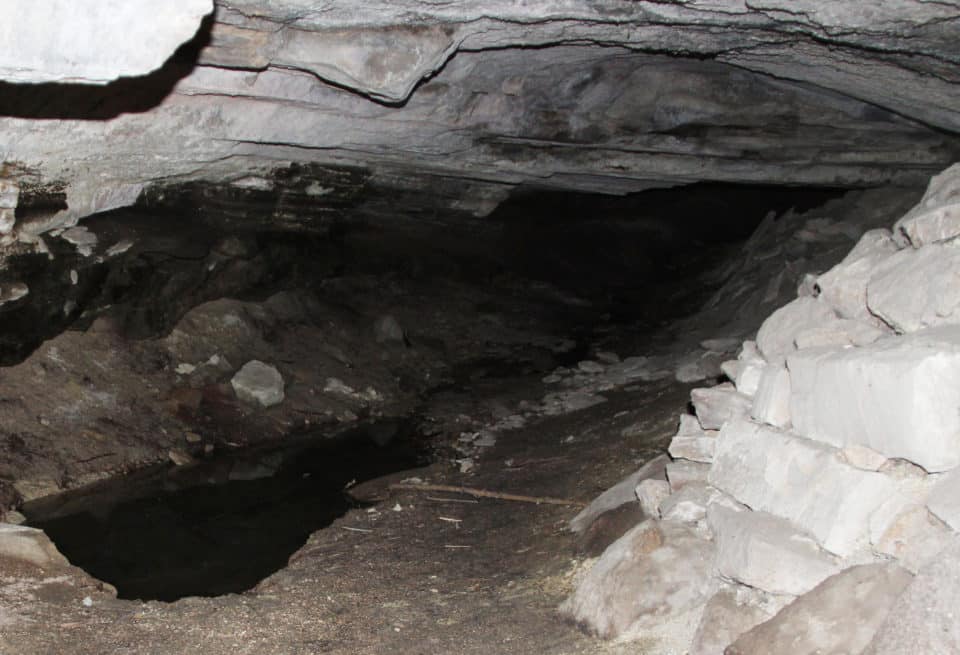
There is evidence that prehistoric people occupied the cave and surrounding area from 10,000 years before present (BP) through 1540 AD. Evidence also shows that the cave and surrounding area was occupied by modern tribes from the 1540s through the 1840s. European contact occurred as early as the 1540s by the Spanish Conquistadors in the North American Continent.
The cave is also associated with a trail that became known as the Cherokee Trail in the mid-1800s. It is likely that portions of the route were used by prehistoric peoples and modern tribes long before European contact. The Cherokee Trail was an overland route that started in Salina, Kansas and provided connections for those traveling north to the Oregon Trail, or the Santa Fe Trail to the south. Diaries written in the mid-1800s document travelers using the cave for shelter, where they stopped to rest along the way. The route was known as the Jimmy Camp Trail and Cherokee Trail in the mid-1800s by immigrants traveling to California during the 1849 Gold Rush. The Board of Douglas County Commissioners currently owns the property that the Blackfoot cave is located on.
To view artifacts that were excavated from the site, please visit the Douglas County Virtual History Museum.
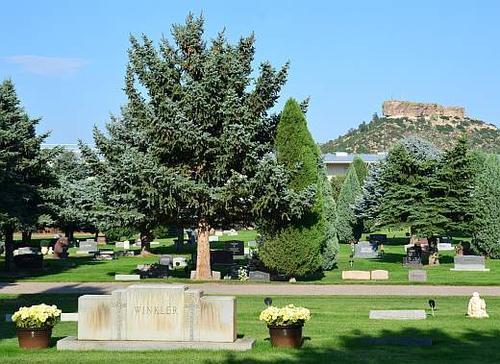
The Cedar Hill Cemetery was founded in 1875. In 1888, a cemetery association was formed, and in 1951, a special district for the cemetery was established. Cedar Hill is the only cemetery in Castle Rock and contains the remains of pioneers significant in the early history of Castle Rock and Douglas County. John Dyer, a famous pioneer, is buried in the cemetery. He was an itinerant Methodist minister who ministered to the many miners and their families in the mountains of Colorado. His image can be seen in a stained glass portrait in the rotunda of the Colorado Capital. Town founders buried in the cemetery include John Craig, Samuel B. Smith, and Benjamin Hammar.
In addition to being the resting place of early pioneers, the historic section of the cemetery contains numerous unique stones and markers that represent the culture and lifestyles of various Douglas County families. The Cedar Hill Cemetery is currently owned by the Cedar Hill Cemetery Association.
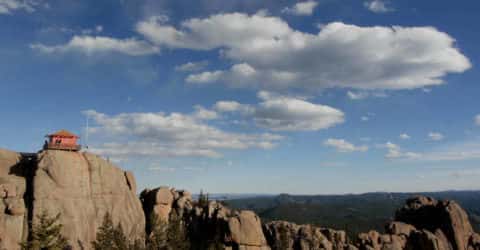
The station was first established in 1912, with the original tower built in 1919. In the summer of 1951, the old tower was dismantled and the current structure was built. In 1991, Devil’s Head Lookout was added to the National Register of Historic Places. Sitting at the highest point of Rampart Range (elev. 9,748 feet) the fire lookout is the last remaining such structure to be in service along the Front Range of Colorado. The view from the current structure extends at least 100 miles in every direction on clear days.
In addition to being the resting place of early pioneers, the historic section of the cemetery contains numerous unique stones and markers that represent the culture and lifestyles of various Douglas County families. The lookout is currently owned and maintained by the Pike National Forest Service.
Fletcher Ranch, located near Sedalia, was designated on March 18, 2003, and nominated by Susie Appleby.
Fletcher Ranch is an excellent example of the early ranching tradition of Douglas County’s upper South Platte River country. Originally homesteaded by Farita and Annie Ammons in the late 1880s, Fletcher Ranch eventually became a part of the Platte River Cattle Company, owned and operated by Elias Ammons.
The ranch served a significant role in the community of the river valley. Remnants of the old stage road from South Platte Station to the mining town of West Creek can still be seen on the Fletcher Ranch today. Additionally, the Sylvia School, or the Horse Creek School in District #21, was located on Fletcher Ranch and served the area from the early 1880s until the early 1930s. This one-room schoolhouse is still on the property and is used as a cabin by ranch owners.
Today, Fletcher Ranch is the only remaining cattle ranch in operation in the river valley and is private property.
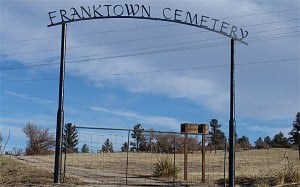
The Franktown Cemetery was established in June 1870 and is one of the oldest, continuously used cemeteries in Colorado. It has a number of historic headstones and grave markers using a variety of materials and styles, including several ornately carved markers for members of two fraternal organizations of the woodsmen.
The cemetery is the burial place for many pioneers of Douglas County and the State of Colorado. Clara Kelly was the first Douglas County resident to be buried in the cemetery in June 1870. Perhaps the most notable pioneer to be buried in the cemetery is James Frank Gardner. Gardner established “Frankstown” by naming his land claim Frank’s Town. He served as county clerk, and later, as treasurer. He also served as a territorial legislative representative, a state senator, and a county commissioner. Other settlers buried in the cemetery include Jacob and Benedict Schultz, John Campbell, and members of the Kelty, Wheeler, and Brackett families. The Cemetery is currently owned by the Franktown Fire Protection District.
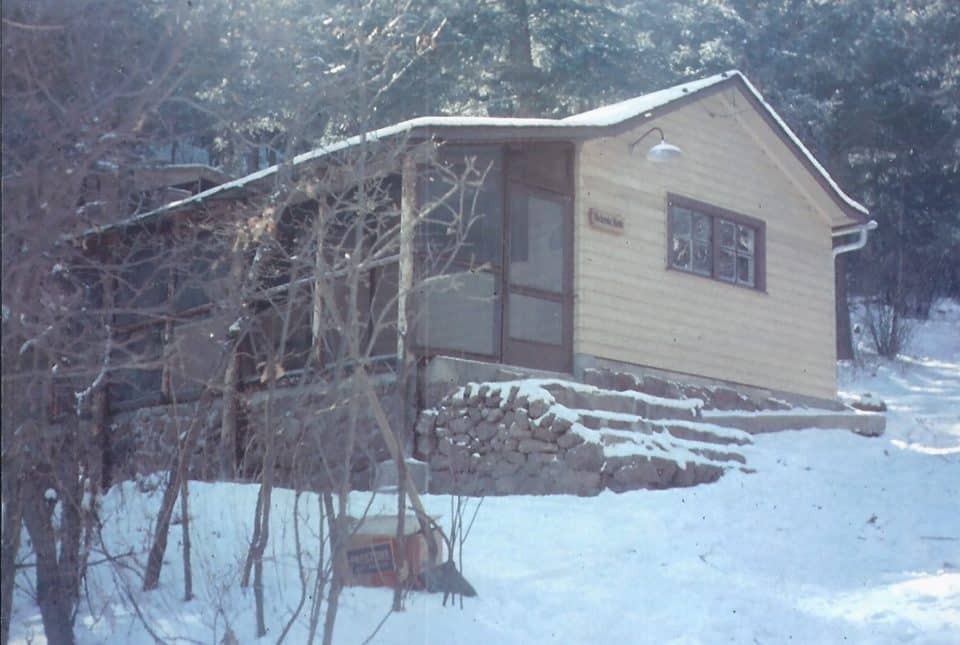
In 1955, Robert LeFevre established the Freedom School as a fulltime graduate school that focused on teaching and spreading the Libertarian philosophy and movement. The school officially opened on June 3, 1957, with its first class of four students, who attended the Freedom School’s two-week summer sessions. By late-1963 the Freedom School’s name was officially changed to Rampart College.
The period of significance is from 1955-1968; the timeframe when Robert LeFevre purchased the property and began constructing the buildings to operate the college. LeFevre worked throughout his life to teach his belief in economic freedom.
The property is significant for its contribution to the creation and growth of the Libertarian movement in the United States. Many well-known and influential executives attended this school, including the Koch Brothers of Koch Industries; Ludwig Heinrich Elder von Misas, a philosopher and Austrian School economist; Milton Freidman, an American economist and professor at the University of Chicago, who won the Nobel Memorial Prize in Economic Sciences; Any Rand, the famous author, playwright, and philosopher; the Hunt Brothers, well-known oil and silver speculators; Friedrich Hayek, Austrian economist; and Rose Wilder Lane, daughter of the popular journalist and political theorist.
There are 13 contributing structures that were built during the property’s period of significance; this is when the Freedom School and Rampart College taught students about Libertarianism. There are several dormitories, administration and maintenance buildings, and lodges that were constructed for the teachers and faculty. The architectural style of the property is characterized as Rustic, meaning the buildings are designed to blend with the surroundings and the natural environment. They are constructed of stone and logs. This architectural style is usually found in vacation homes, dude ranches, and tourism-related facilities. The Douglas County School District currently owns the Freedom School.
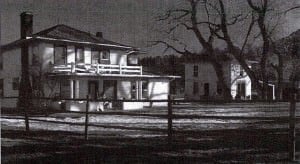
The Frink House was built between 1913 and 1914 by an unknown builder; however, there is evidence to suggest that Harry Kinner constructed and then sold it to Ellen Frink in 1914. The chimney on the Frink House was branded with a symbol that looks like a combined 3G, with a backward “3” at the top and a backward “G” towards the bottom.
Ellen’s husband, Clarence, was a partial owner of the Carlson & Frink Creamery, which grew and expanded across many parts of the state. The creamery they owned in Larkspur was well known for its Black Canyon Cheese.
The house is a modified Foursquare, which uses a square footprint, two-story structure, and simple decoration. It has the original woodwork and floors with a dining room, kitchen, and enclosed porch jutting out from the traditional square. The footprint of the house has not changed in more than fifty years. The property is currently held under private ownership.
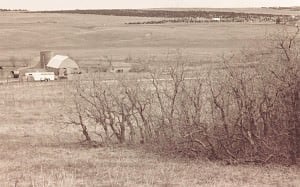
This 22-acre property was part of a larger 720-acre homestead filed by Gideon Pratt in 1869. Gideon was active in state and local government, serving as a state representative, county commissioner, and county assessor. Gideon Pratt donated an acre of land upon which the Pratt School was constructed. The school was destroyed by fire around 1899. The homestead was sold by the Pratt family in 1902 upon Gideon’s death. The house was subsequently destroyed by fire in 1911.
The homestead is also the burial site of one of Gideon and Lydia Pratt’s nine children, Harry C. Pratt. Gideon, Lydia, and the other children are all buried in the Cedar Hill Cemetery. The property is currently privately owned.
Greenland Townsite, located south of Larkspur, was designated on September 13, 2011, and nominated by Penny Burdick. The Greenland Townsite is currently owned by Douglas County and others.
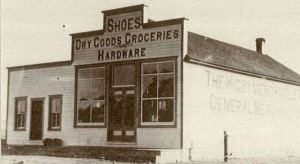
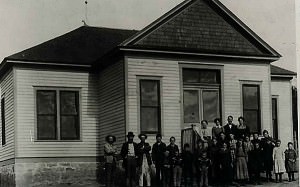
The Hilltop School is one of the last remaining examples of a small rural schoolhouse in Douglas County. Built in 1898, the Hilltop School served children from the community of Hilltop and Elbert County until 1954.
The two-acre school site consists of the original schoolhouse, coal shed, well house, oil bunker, and outhouses. All of these structures remain on the property except for the horse shed. Since closing in 1954, the schoolhouse has been cared for by the Hilltop Social Club.
Horace Persse Homestead, located in Roxborough, was designated on September 30, 2008, and nominated by Susie Trumble and Justin Ober. The Homestead is currently owned by the Colorado State Parks Service.
The brick ranch house was constructed in 1908 by Horace Henry Persse to complete the requirements for his application for land under the Homestead Act. The house was constructed of silica brick manufactured at the Silicated Brick Company, which is located approximately two miles north of the site. This house is one of two silica brick houses remaining in the Roxborough area, but 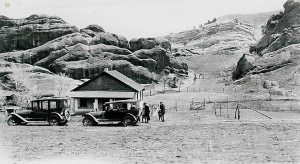
David Reed bought the house from Persse in 1916 and remained there for four years. Not much is known about Reed. In 1920, Reed sold the house to Eliza Skinner for $4,250. She raised hogs on the land until 1929. In 1929, the property was purchased by Grace Church Jones, an artist whose work consisted of French and American landscapes, children at play, figure studies and still lifes. She painted murals in the school auditorium of Morey Middle School in Denver, which still exists today.
W. Bonner and La Cleta Brice purchased the property in 1946 and owned it for nearly 60 years coining it the Sundance Ranch. The family raised sheep, horses, turkeys, calves, and pigs. The Brice family made many improvements to the ranch, including remodeling the interior of the brick house to add a bathroom, kitchen, and electricity as well as rebuilding the large barn. The Brice’s hoped to operate the property as a dude ranch. La Cleta’s father built a two-unit log-sided guest cabin in 1950. Between 1979 and 2002, the family sold parts of the ranch to the State of Colorado for inclusion in Roxborough State Park.
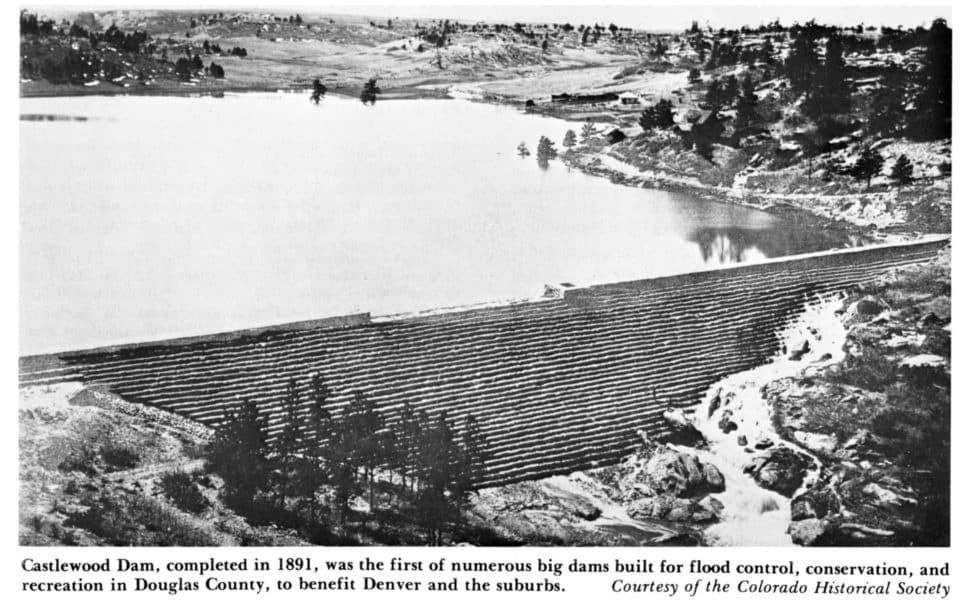
In 1887 Paul Kleinert filed a homestead patent that consisted of 160 acres of land. He built a log cabin and made other ranching-related improvements. Through time his financial standing improved. He married and raised a family, and while tending his cattle and other ranching duties he also kept a close eye on the Castlewood Canyon Dam, which was completed in 1890. Mr. Kleinert voiced concern about the dam’s stability. His future son-in-law, William Heim, was the dam’s caretaker. William married Paul’s daughter Theresa in 1909. After her father’s death in 1949, Theresa became co-owner of the Kleinert Ranch with her brother, Paul. The Castlewood Canyon Dam collapsed in 1933, wreaking havoc all the way through Denver. It was just east of the homestead.
Many stagecoach roads were located in the eastern portion of the County since the county seat was in Frankstown. Castlewood Canyon Road, originally a toll road, delineates the eastern edge of the property. In 1888 Mr. Kleinert requested County approval for a private road from his property to junction with the toll road.
Geologic processes created the Castle Rock conglomerate formation, leaving behind an outcrop with a wet cave. The Kleinert’s would use the water in the cave to irrigate the hayfields and other crops.
Kreutzer Homestead, located in Sedalia, was designated on April 11, 2000 and nominated by Carol Meyer, and is currently privately owned.
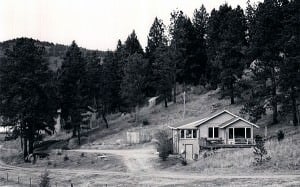
Edward Kreutzer homesteaded the land with his family beginning in 1878. He contributed to the early development of the County by helping to establish the first Douglas County High School. He also served as Justice of the Peace in Sedalia and Secretary of the School Board for District #5 and #7.
William Kreutzer, Edward’s son, became the first U.S. Forest Ranger in 1898 and was the only ranger in Colorado at that time. He served 41 continuous years until his retirement in 1939. A 13,120-foot peak is named in his honor in the Gunnison National Forest of Colorado.
Loraine Ranch, located near Spring Valley, was designated on April 14, 2015 and nominated by Penny Burdick, and is currently privately owned.
Joseph Loraine, whose ancestors were from France, was born in Florissant, Missouri in 1854. He came to Colorado circa 1900, eventually purchasing the property that would come to be known as “Lorain Ranch” in 1905. In 1907, Loraine married Ada Bucks, who was the daughter of two Spring Valley pioneers, Harrison, and Sallie Bucks. Ada’s father helped to build the Spring Valley School that she attended. Later Ada went to Denver High School and in 1904 the Colorado State Normal School, where she received a degree in education. She began her teaching career at Spring Valley School and taught at Columbine School before getting married.
Through the years Loraine purchased more property until he acquired over 300 acres. Ada and Joseph had three children: Ruth, Sallie Beatrice, and Julia. The family raised milk cows, horses, chickens, potatoes, and field crops. They would sell the milk to creameries in Larkspur and Colorado Springs. A Record Journal April 13, 1917, article reported: “Joe Loraine shipped registered Shorthorn bull from one of the most noted Shorthorn milk strains in Colorado, at a great price of nearly $400 for an 11-month-old bull.” Today, that is equivalent to approximately $8,000.
Joseph died in 1937 and Ada died in 1946. They are both buried at the Spring Valley Cemetery.
Born at the ranch in 1908, Ruth Loraine would help to milk the cows before going to school. When she was just 7 years old, during her first day at Spring Valley School, Ruth knew she wanted to be a teacher. Following in her mother’s footsteps, she received a teacher’s degree. Later she received a master degree from Colorado College. Ruth taught school for 47 consecutive years beginning in 1927, and just like her mother, her first teaching job was at Spring Valley School. Ruth finished her career in Fountain at East Elementary School where she retired in 1974. As a testament of her dedication and enthusiasm, the school was renamed Lorraine Elementary School in her honor. Ruth passed away in 1996 and is buried at the Spring Valley Cemetery.
Louviers Village Club, in Louviers, was designated on April 15, 2008 and nominated by Joyce Rovetta, and is currently owned by Douglas County.
The Louviers Village Club was approved for the National Register of Historic Places on September 1995. In July 1999, Louviers Village was designated as a Historic District on the National 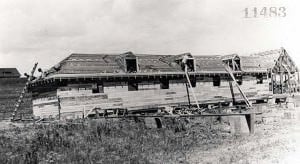
The Club was constructed in the Craftsman style. It was unusual to find in rural Douglas County this level of architectural sophistication. When complete, the Club was the largest building of its kind in the County.
The DuPont Company built the Louviers Village Club to bring employees together for entertainment and recreation. Upon its opening, the Club housed an assembly hall and a billiards room on its main floor. The assembly hall was used for a meeting room, dance hall, and moving picture theater. A bowling alley was adjacent to the main building. DuPont sponsored the bowling league.
The uses of the building changed over the years. For example, at various times it housed a mercantile store, post office, shooting range, reading room, barbershop and concession stand. With partial funding from a State Historical Fund grant, the County restored the Club between 2001 and 2007.
Lowell’s OV Ranch, south of Castle Rock, was designated on March 30, 2010 and nominated by Angie DeLeo and Penny Burdick, and is currently owned by The John E. Lowell and Beatrice B. Lowell Trust and the Lowell Family Foundation
Benjamin Hammar first homesteaded the property in 1877, where he raised sheep instead of cattle. He was also associated with the development of the rhyolite quarry business having interest in the Colorado Stone Company. Mary Ellis purchased the property from Benjamin Hammar and deeded it to her husband Charles Henry Ellis. Charles was involved in early dairying and was a 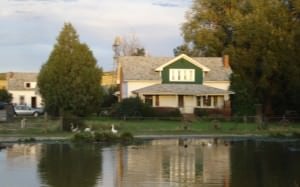
Henry Lowell and his family moved to the property in the early 1900s where Henry served as ranch manager. In 1919, Henry became the sole owner of one of the largest ranches in the County. As the Lowell Family settled into living on the ranch, they got involved in many local activities, and Henry became a community leader. He was a member of the Masonic Order and the Pikes Peak Grange, served on the Douglas County School Board, and was the director of the National Farm Loan Association. In addition, Henry Lowell’s son John served for four years as a director of the County’s Economic Development Council to influence growth planning, and as the County Assessor from 1964-1978.
The Lowell Family supported ranching through joining agriculture related organizations, such as the Douglas County Dairyman’s Association, the Douglas County Farm Bureau, the County Fair and 4-H. To that end, the Lowell Family established a foundation on March 10, 2003, to ensure that the ranch continue to be used for agricultural education. The Colorado Agricultural Leadership Foundation (CALF) provides school tours, information about raising livestock and other youth agricultural education programs including providing 4-H support.
Lucas Dairy/Shady Springs Ranch, in Cherry Valley, was designated on June 30, 2009 and nominated by Pricilla Queen, and is currently privately owned.
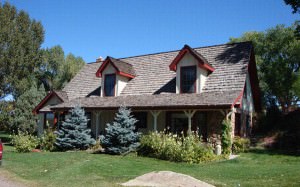
During historic times, the ranch was first settled by Caleb Essington ca. 1890. It was absorbed into Hagspiel Ranch in 1907. Verna and Hugh Lucas moved to ranch in 1920 and stayed for 61 years, and they dairy farmed and raised winter wheat and hay. In 1978, the Lucases sold the ranch to the Gordons, who stayed for 10years. Starting in 1988 it was owned by Lostys for 6 years.
In 1994, the ranch was bought by Queens, the current owners, and they named it Shady Springs Ranch. The Queens have done a lot of renovation and repair work on the main house, and they continue grass harvesting, wheat hay cultivation, beef steers and sheep production, beekeeping, and chicken and heritage turkey raising.
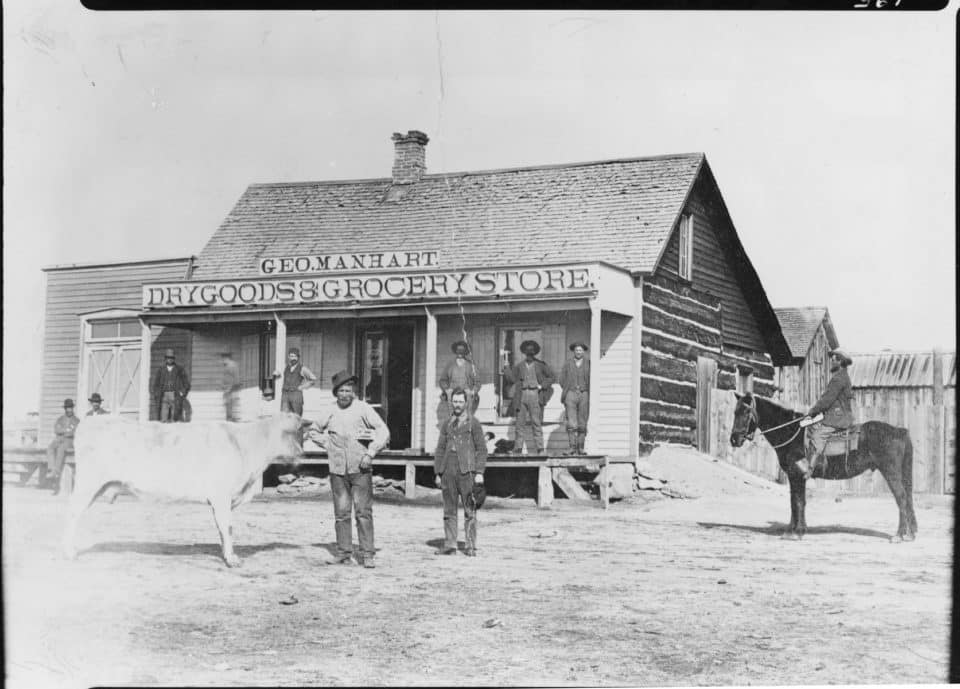
George Washington Manhart established a successful mercantile business in the Town of Sedalia in March 1878, where it grew from a one-room cabin to a two-story, 1,800 square-foot, rhyolite-constructed building by 1889. George Manhart was a successful businessman, who served as postmaster and president of the Sedalia school board. The Manhart House is nominated based on its association with persons significant in history. The house represents George’s successful mercantile business and served as the family’s residence from the time it was built in 1909 until George’s decedents sold it in 1973.
The current Manhart House was built in 1909 by Benjamin Taylor Saunders, Sr., who also built the Cherokee Ranch Castle. The house has no distinct architectural style; however, it does have elements of the Queen Anne style, which includes broad porches, fine brickwork, and a central triangular pediment set against a hipped roof. The house is a front gable masonry building facing south on a concrete foundation with an asphalt shingle roof and arched eaves. There is a dormer on the west elevation above a three-sided bay window. The porch has a shallow gable roof with non-historic round, painted, steel columns. Today, this house operates as a popular restaurant.
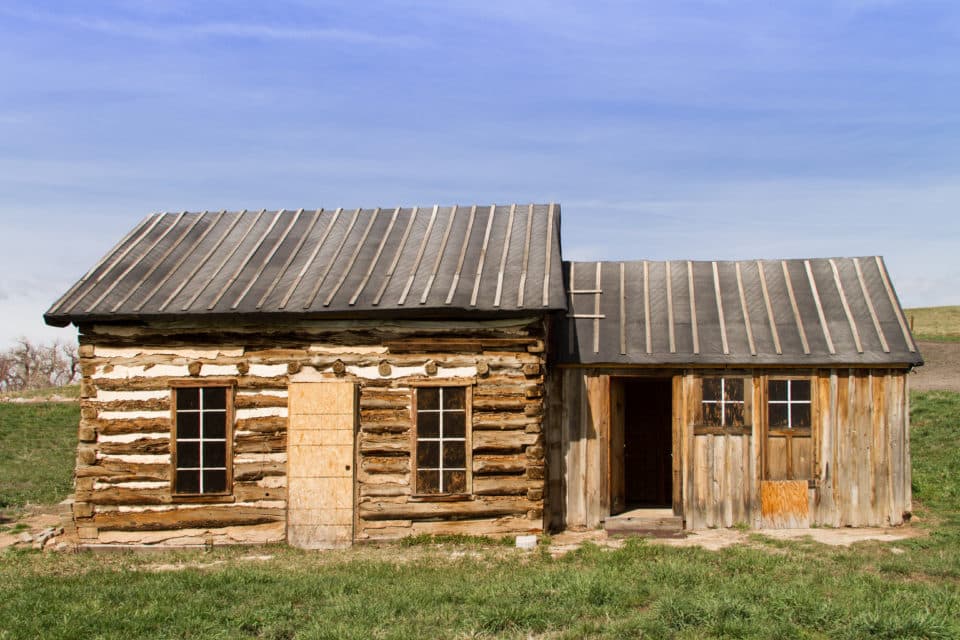
Sitting along the Highline Canal in northwest Douglas County, the log cabin is constructed of logs. Its interior consists of one large room with a flight of stairs up to a loft. The walls are exposed log that at one time were whitewashed. The loft has a wood floor with log walls and horizontal boards in the gable ends.
Built by Amos C. Miksch, who served as a private in the First Cavalry Regiment of the Colorado Volunteers, and witnessed the Sand Creek Massacre, this circa early 1870s cabin is a testament to the endurance of the immigrants who came to Colorado during its pioneer era. In the Homestead Application for a 160-acre claim, Miksch stated that he built the cabin, stable, corral, chicken house, cellar, milk house, fenced twenty acres, dug a well and irrigation ditch. After proving up the property, Miksch sold it to Frederick Neumyer in 1873, who owned it until 1883 when he sold it to Franz and Judith Helmer. During their ownership, the Helmers built a cattle ranching operation that eventually grew to over 3,200 acres. The descendants of Franz and Judith lived on the property for over 100 years.
The cabin is an excellent example of pioneer log architecture now rare in Douglas County. Its character defining features are the hand-hewn logs that are laid with a square notch technique, the original front door on the oldest portion of the cabin, the ½ story loft, the gabled roof, and the original double-hung windows located on the west elevation of the original part of the cabin. The south addition was built prior to 1920 and is constructed of wood-frame with board-and batten siding.
Pikes Peak Grant #163, located in Franktown, was designated on May 22, 2012 and nominated by Mary O’Pry. The cabin is currently owned by Pikes Peak Grangers #163.
Organized on March 14, 1908, Pikes Peak Grange #163 first held meetings at the 1884-era Founder School. The grangers wasted no time in establishing their own hall. In August 1908, Granger William E. Converse donated the land and granges made plans to construct a hall on the one-acre site. Members donated work and money, which also including holding many fundraising events. The building was dedicated on March 5, 1909, and is the only remaining grange in Douglas County that is still active.
This grange hall is a good example of the architectural style that was typical of many of the buildings constructed by pioneers in rural Colorado during the 1860s- through the early 1900s. The vernacular front-gabled, wood-frame, rectangular shaped building sits on a rhyolite stone and concrete foundation.
Prairie Canyon Ranch, located in Franktown, was designated on October 3, 2000 and nominated by Toby Sprunk. The ranch is currently owned by Douglas County.
This property was homesteaded by Frederick Bartruff and his family in 1873 and has been used as a working cattle ranch since that time. The collection of buildings illustrates significant advances in agricultural and architectural technology from the 1870s to the 1930s. The land is also rich in archaeological resources, with evidence of human occupation up to 9,000 years ago.
The property consists of several historic structures including a house, barn, bunkhouse, grain building, chicken house, garage, granary, outhouse, cave, cemetery, and stone corrals (circa 1875-1938). The ranch is characterized by rolling grasslands, mixed pine and Gambel oak forests, rocky outcrops, narrow canyons, riparian areas, and lush hay meadows. The ranch was acquired because of its diverse wildlife habitat. Hawks, pronghorn antelope, coyotes, deer, elk, and great blue herons are known, inhabitants.
Douglas County manages the property as a working cattle ranch. Access to the property is for organized groups including educational tours for school groups and horse rides. Public access is by appointment through Douglas County Open Space and Natural Resources at 303-660-7495.
Pretty Woman Ranch, in Sedalia, was designated on April 4, 2006 and nominated by Susan Trumble, and is privately owned.
The Pretty Woman Ranch was built along one of the first territorial roads from Denver City to Pueblo. Though already well-traveled and known as the Plum Creek/Divide Wagon Road, the territorial road was designated by an act of the Council and the House of Representatives of Colorado Territory in 1862.
In 1861, Sylvestor A. and Elizabeth Bowers Richardson constructed a dugout cabin on the west side of the territorial road. The crude building measured 8 feet by 10 feet and had no windows. In 1862, a larger log cabin was constructed south of the dugout by the Richardson family. It served as a hostelry, home, and post office. The post office was known as the Bennet Springs Post Office and operated between December 1862 and September 1865.
Sylvester Richardson served as one of the first triumvirate Douglas County Commissioners appointed in the spring of 1862. He tried his luck at ranching while his wife fed and housed travelers along the territorial road. Elizabeth was known for her beauty and the Richardson place soon became known as the “Pretty Woman Ranch.” Denver Richardson was born to Elizabeth and Sylvester on January 26, 1861. He was regarded by many as being the first white child born in Denver, Colorado.
The Richardsons operated their ranch and hostelry until 1864, when the route of the territorial road was altered to follow Plum Creek to Sedalia and then up West Plum Creek. Fewer travelers along the old route meant less business for the Richardsons. Elizabeth and Sylvester were divorced in 1868. She returned to her family in Wisconsin and later remarried. Sylvester went on to lead several expeditions to explore the Gunnison Valley and settled what was called Richardson’s Colony. He is known as the founder of Gunnison County.
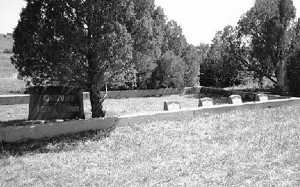
This one-acre cemetery is located on top of a hill in Cherry Valley. At one time the Territorial Road passed within a quarter-mile west of the cemetery. John Proctor deeded the cemetery to the Rock Ridge neighborhood on July 5, 1880, for $5.00. The cemetery was used by early homesteaders to bury their family members. There are 28 headstones, the oldest being that of Hannah Proctor who died in 1870, and the latest being that of Chris Schreiber who died in 1953. It is believed that more people are buried in the cemetery without markers. At one time wooden markers were used which later disappeared.
Rock Ridge Ranch, located in Cherry Valley, was designated on December 12, 2000, and nominated by Janet and Charles Herman, and is privately owned.
This land was part of a larger homestead, filed in 1874 by Peter DuMont. The Case family subsequently acquired the land, also establishing the Case Creamery, cheese factory, school, cemetery, and post office. The Hilyen family owned the land from 1900 to 1970, and grew crops and raised milking shorthorns. The ranch came to be known as Rock Ridge, for the prominent rock-strewn ridgeline located east of the ranch house complex.
The original ranch house was constructed c.1876 and has had numerous additions made to it over time. The barn was built c.1874 of hand-hewn/pegged pine, from lumber milled in the Russellville area. It was also added to over time. Other structures include a milkhouse constructed in 1880 of native rhyolite, and an outhouse built by the Civilian Conservation Corp c.1930s. The ranch was located on the Old Post Road (1874), which linked ranch residents to Golddale, Franktown, and other communities. Artifacts have been found on the property, dating from 200 to 8000 years ago.
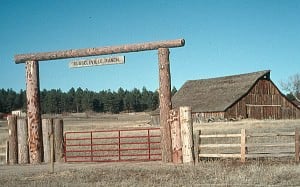
This area of Russellville was associated with the trail system used by travelers in the 1830s, later known as the Cherokee Trail. The Cherokee Trail extended from Taos to Ft. Laramie. In 1858, the William Green Russell party found small amounts of flour gold, which contributed to the 1859 gold rush to Colorado Territory. In 1861, Russellville became the earliest community in what would become Douglas County. The buildings on the ranch that contribute to the historical significance of the property include the c.1861 stage barn, the icehouse (which retains its original rhyolite foundation), the c.1859 springhouse, and the 1930 dairy barn/stable. Rubble from the original hotel also remains on the ranch.
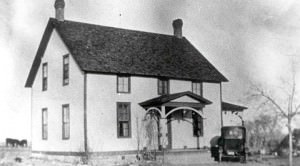
The Happy Canyon Ranch was purchased by John and Joseph Schweiger in 1874. A ranch house and outbuildings were constructed on the property between 1894 and 1910. The ranch is an excellent example of early framing and ranching properties in Douglas County and was used for over 100 years. Most of the original buildings still exist on the property, along with remnants of an apple orchard. A portion of the Arapahoe Canal was located on the property with remnants still visible today.
Sedalia Fire Station, in Sedalia, was designated on March 13, 1999, and nominated by Barbara Machann, and is owned by the West Douglas County Fire Protection District.
The station was built in 1933 through the cooperative efforts of prominent citizens and organizations of the community, including merchants, ranchers, churches, lodges, and women’s groups. It replaced the original Sedalia firehouse, which was built in 1907. The building is distinctive for its period construction and includes the bell and bell tower from the original firehouse. The cornerstone, which was laid in a ceremony honoring the founders and the history of the Sedalia Fire Department, contains a time capsule preserving records of that history.
Sedalia School House, in Sedalia, was designated on November 7, 2000, and nominated by Tara Sakraida, and is privately owned.
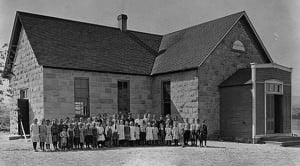
The school was built of rhyolite stone quarried in Castle Rock. The building was enhanced by a steep gable roof, and a large gabled entry room of wood construction, coupled with a facade of plain and fish-scale shingles above the center window and front door. The 1912 addition included improvements such as gaslights, a stoker furnace and water pumped in for a drinking fountain. Electricity was added in 1935.
The school still stands today and houses two apartments.
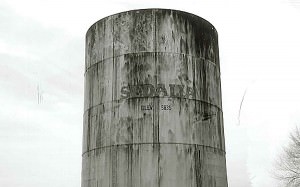
The Sedalia Water Tank was constructed in 1890 by the Santa Fe Railroad and served as a water supply for the locomotives until diesel supplanted the use of coal-fired steam engines. Today, the water tank serves as the main water supply for Sedalia. The tank was listed on the National Register of Historic Places in 2002 for its role during the steam era of the rail system and for its contributions to Colorado history.
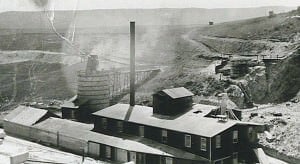
The Silicated Brick Company played an important role during the 1900 to 1920 time period in the development of industry and rail transportation in the northwest region of Douglas County. The brick company was also responsible for an increase in population of this sparsely settled corner of the County. A small community, known as Silica, was identified on the 1915 and 1937 maps of Douglas County. This community consisted of 6-8 homes immediately west of the brickyard.
The Silicated Brick Company operated as a brick manufacturing plant from 1904 to 1916. In 1909, the Colorado and Southern Railroad extended a branch line to the site to haul bricks and raw materials into Denver. In 1910, the company employed 27 men in the mining of local mineral deposits and the manufacture of silica bricks. By 1912, the company was struggling and the Silica Brick and Clay Company was formed to take over the operation of the brick plant. By 1916, this company also failed. By 1919, the property was acquired by the Helmer family and the area returned to ranching and mining mineral resources.
The rise and fall of the Silicated Brick Company and the small community of Silica is representative of early 20th-century industry and growth.
Photographs taken in 1910 show that the site of the Silicated Brick Company once comprised several structures including a limestone kiln, brick manufacturing building, superintendent’s office, boarding house, a railroad coach or mail car converted to dormitory housing, and several outbuildings. A spur line of the Colorado and Southern Railroad known as the “Silica Branch” ran from Platte Canyon to the site of the brick company. The property comprises approximately 1.5 acres and contains the remains of the lime kiln, cart track south of the kiln and some remaining walls of the brick manufacturing building west of the kiln.
Spring Valley School District No. 3, located in Spring Valley, was designated on March 17, 2009 and nominated by Penny Burdick, and is privately owned.
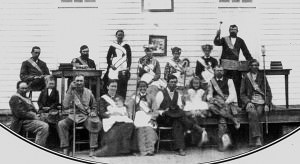
The exact date that the schoolhouse was built is unknown, but it is believed to have been between 1870 and 1878. The school is a standard design of a single-story vernacular, lap-sided, wood-framed building. It has six double-hung windows, a shake-shingled roof, and a rock foundation. A hand-dug well is located east of the building. There is also a coal house, outhouse, and barn on the property.
The Spring Valley School is located halfway between Franktown and Colorado Springs near the headwaters of the Cherry Creek watershed just north of the Palmer Divide. The fertile soil is fed by numerous underground springs, which made it possible to raise diverse crops including potatoes, beans, sugar beets, and native grass hay.
Twin Creek Ranch, in Castle Rock, was designated on February 9, 1999 and nominated by Cecilia Gryde, and is privately owned.
Frederick and Charles Doepke came from Austria and homesteaded the Twin Creek Ranch in 1861. Because this was fertile farmland with an ample supply of water, they soon prospered and added extensive amounts of land to their holdings. They soon acquired dairy cattle and operated a successful dairy, which continued to produce milk, cream, and butter into the 1950s. The Doepkes also grew wheat, oats, corn, and hay. The Doepke household became known for its social events and as a gathering spot for the German community of Lake Gulch. Frederick Doepke became a leader in the County and was instrumental in establishing the first school board.
The two-story brick farmhouse was constructed in 1881. The bricks were hand made by Frederick and Charles from the clay and sand deposits found on the ranch. The basement walls and foundation are constructed of native rhyolite stone.
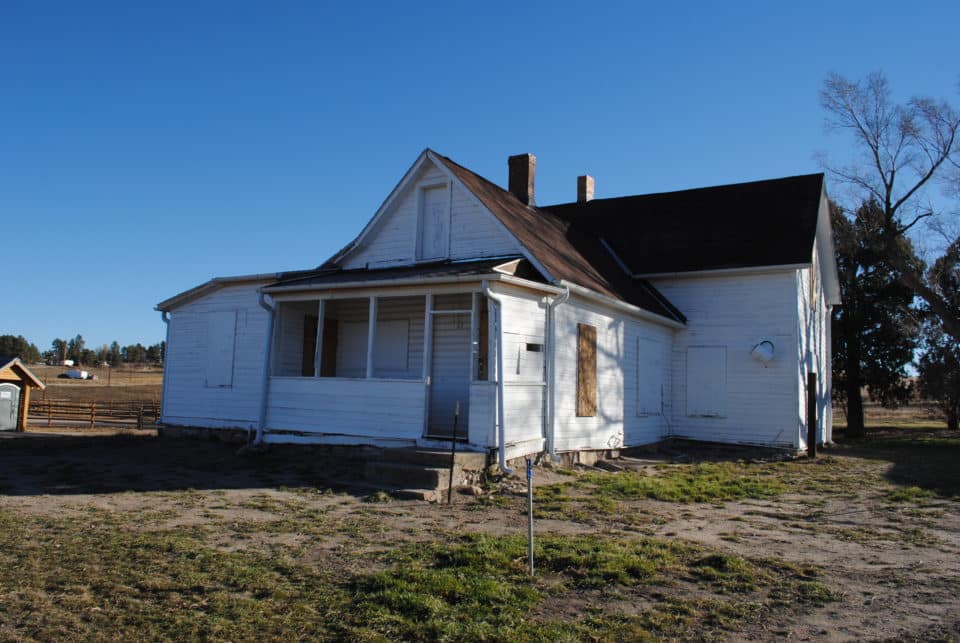
William Converse migrated to Colorado in 1875, settling in Franktown in 1880. He married Ida Kracaw in 1885, a year after he purchased the ranch. They had four children, Mary, Charles, Austin, (who died shortly after being born) and Roger. In addition to being a rancher, Converse also generously gave back to his community. In 1908, he donated part of his land that was used for the Pikes Peak Grange No. 163, which is State and National Landmark as well as a Douglas County Landmark. Converse served on the Franktown District No. 2 School Board beginning in 1888, and planted over 3,000 different varieties of trees on the southeastern portion of the property, when he filed application to plant trees under the Timber and Culture Act of 1878.
The two-story main house, chicken coop, pump house, and granary are significant as good examples of vernacular architecture, retaining their physical integrity, and design features. The wood-frame two-story main house is distinctive for the unusual style of its front-gabled dormers. The early additions to the remainder of the house reflect the family’s natural growth and perhaps economic prosperity. The property retains the historic and spatial integrity associated with the operation of a successful working ranch. The chicken coop, pump house and granary are located behind the residences in a typical spatial relationship to each other.
The one-story 1930s house was moved to this property sometime after 1937 and was likely the home for one of William Converse’s sons involved with the operation of the ranch. It exhibits Arts and Crafts detailing on its original windows and doors; an architectural style that is unusual in Douglas County.
YMCA Camp Shady Brook was designated on January 6, 2009.
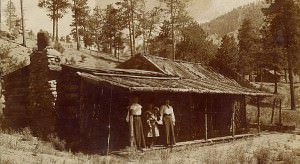
Robert Bandhauer and his son built the original structures on Shady Brook Farm. He was a skilled blacksmith, and crafted the ironwork in the old Tabor Grand Opera House and the old Denver City Hall at 14th and Larimer, which was torn down in 1945. He held multiple patents, including the screw clamp for ice, roller skates and the meat hook still used in packing plants.